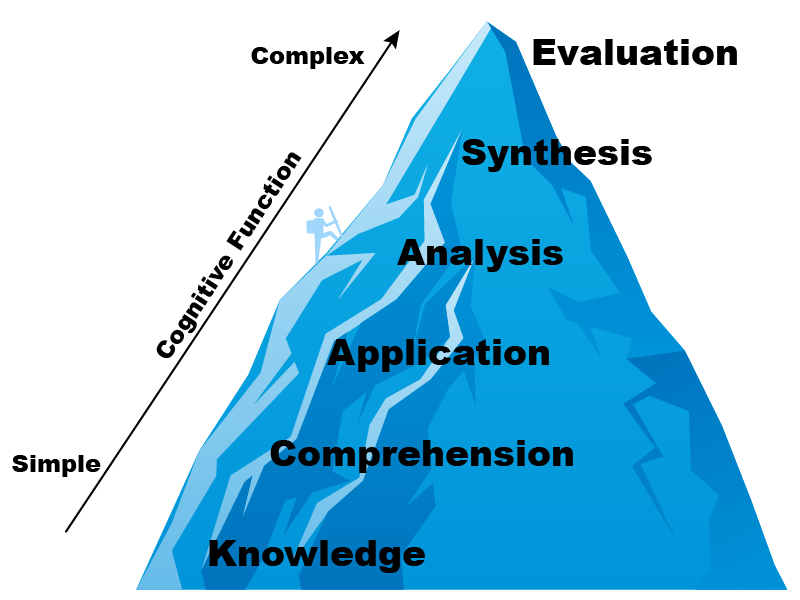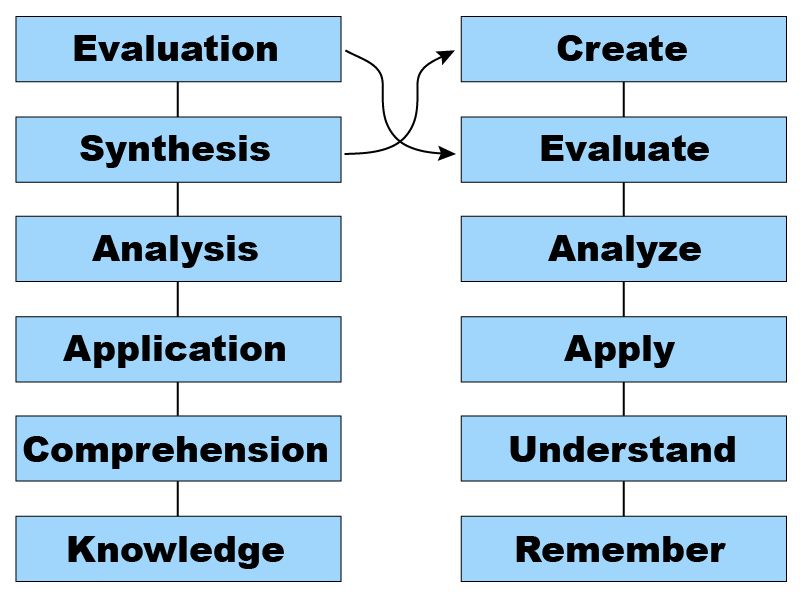Cognitive Objectives
Cognitive objectives are designed to increase an individual's knowledge. Many refer to Bloom's taxonomy of cognitive objectives, originated by Benjamin Bloom and collaborators in the 1950's.
Examples:
- Given a description of a planet, the student will be able to identify that planet, as demonstrated verbally or in writing.
- The student will be able to evaluate the different theories of the origin of the solar system as demonstrated by his/her ability to compare and discuss verbally or in writing the strengths and weaknesses of each theory.
Bloom describes several categories of cognitive learning:

Cognitive objectives are designed to increase an individual's knowledge. Cognitive objectives relate to understandings, awareness, insights (e.g., "Given a description of a planet, the student will be able to identify that planet, as demonstrated verbally or in writing, with 100% accuracy." or "The student will be able to evaluate two different theories of the origin of the solar system as demonstrated by his/her ability to compare and discuss verbally or in writing the strengths and weaknesses of each theory."). This includes knowledge or information recall, comprehension or conceptual understanding, the ability to apply knowledge, the ability to analyze a situation, the ability to synthesize information from a given situation, the ability to evaluate a given situation, and the ability to create something new.
Starting with basic factual knowledge, the categories progress through comprehension, application, analysis, synthesis, and evaluation.
- Knowledge - Remembering or recalling information.
- Comprehension - The ability to obtain meaning from information.
- Application - The ability to use information.
- Analysis - The ability to break information into parts to understand it better.
- Synthesis - The ability to put materials together to create something new.
- Evaluation - The ability to check, judge, and critique materials.
In the 1990's, Lorin Anderson, a former student of Bloom, along with David Krathwohl, one of Boom's original partners, worked to revise the original taxonomy. The Anderson and Krathwohl Taxonomy was published in 2001 in the book "A Taxonomy for Learning, Teaching, and Assessing: A Revision of Bloom's Taxonomy of Educational Objectives."

Note that in the revised taxonomy, synthesis and evaluation are switched. Also, verbs are used in place of nouns to imply the action one takes in each level.
- Remember - Using memory to recall facts and definitions.
- Understand - Constructing meaning from information.
- Apply - Using procedures to carry out a task.
- Analyze - Breaking materials into parts to determine structures and relationships.
- Evaluate - Making jugements based on checking against given criteria.
- Create - Putting materials together to form a unique product.
Whether you like the original or revised taxonomy, there are key verbs for each level you can use when writing cognitive objectives.
| Remember | Understand | Apply | Analyze | Evaluate | Create |
|---|---|---|---|---|---|
|
|
|
|
|
|
Examples for Questions for Each Level
Remember
- Who? What? Where? When? How?
- Describe X:
- What is X?
Understand
- Re-tell X.
- What is the main idea of X?
- What differences exist between X AND Y?
- Write a brief outline.
Apply
- How is X an example of Y?
- How is X related to Y?
- Why is X significant?
- Describe an example of when X happens.
Analyze
- What are the parts of X?
- Classify this according to X.
- Create an outline/concept map of X.
- Provide evidence that X is correct.
Evaluate
- Compare and contrast X to Y.
- Select the best product.
- Critique the play.
- Judge the following in these merits: X, Y, Z.
Create
- Organize the following: X,A,Q.
- Predict what will happen next.
- What solutions would you suggest for X?
- How would you design a new X?
Additional Links
- Major Categories in the Taxonomy of Learning Objectives
- Bloom's Taxonomy of the Cognitive Domain
- Learning Objective Verbs for Specific Disciplines
- Anderson and Krathwohl – Bloom’s Taxonomy Revised
Offline References
Anderson, L.W., & Krathwohl (Eds.). (2001). A Taxonomy for Learning, Teaching, and Assessing: A Revision of Bloom's Taxonomy of Educational Objectives. New York: Longman.
Bloom, B.S. and Krathwohl, D. R. (1956). Taxonomy of Educational Objectives: The Classification of Educational Goals, by a committee of college and university examiners. Handbook I: Cognitive Domain. NY, NY: Longmans, Green.